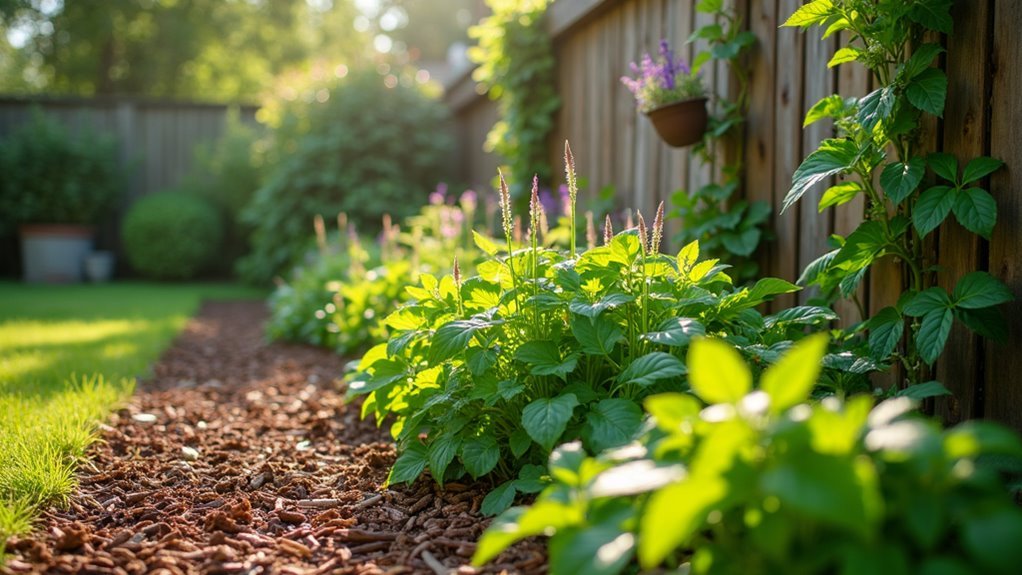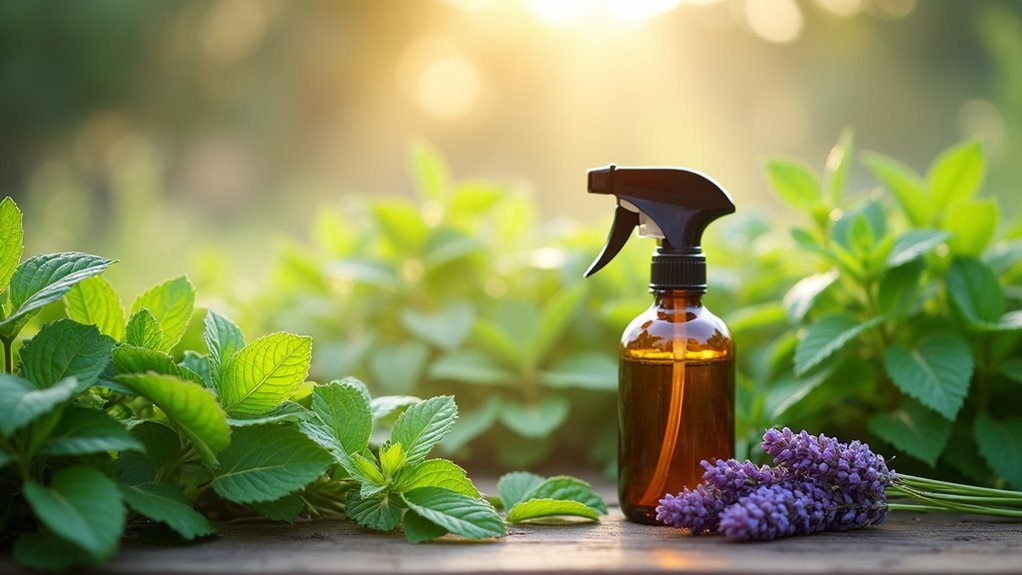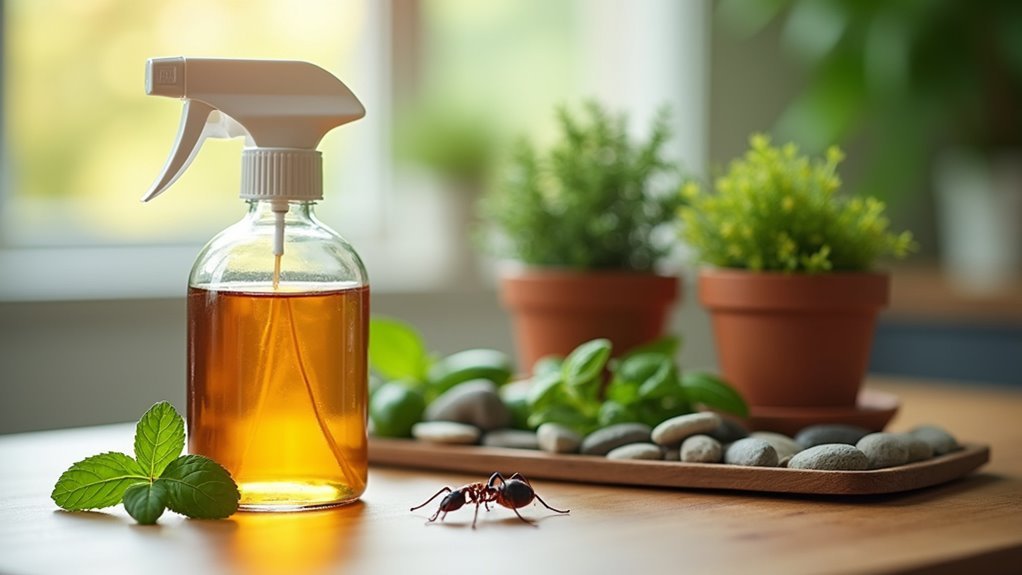You can create effective pet-safe bug barriers using food-grade diatomaceous earth sprinkled around entry points, essential oil sprays made with lavender or peppermint diluted in water, and vinegar solutions that disrupt ant trails without harming your pets. Focus on sealing cracks, maintaining clean surfaces, and strategically placing natural deterrents like crushed eggshells or chalk lines around doorways and windows. These non-toxic methods protect your home while keeping your furry family members safe from harmful chemicals found in traditional pesticides.
Understanding Pet-Safe Pest Control Principles

While traditional pest control methods often rely on harsh chemicals that can endanger your furry companions, pet safe pest control principles prioritize non-toxic approaches that protect both your home and your animals.
You’ll find that natural ingredients like essential oils effectively deter pests without posing health risks to your pets. These methods work by creating barriers that repel insects rather than poisoning them.
Pet safe pest control emphasizes prevention through cleanliness and proper food storage. You can eliminate pest attractions by regularly cleaning surfaces and storing pet food in airtight containers.
Natural solutions like vinegar and water mixtures safely remove pest trails while remaining harmless to your animals. This approach guarantees you’re protecting your home without compromising your pets’ wellbeing.
Natural Diatomaceous Earth Barriers for Indoor Spaces
When you’re looking for a powerful yet pet-safe solution to indoor pest problems, food-grade diatomaceous earth offers an effective natural barrier that won’t harm your furry companions.
This non-toxic powder, made from fossilized algae, creates barriers against fleas, cockroaches, and ants throughout your home.
To establish effective barriers, sift diatomaceous earth onto carpets and surfaces where pests hide. Work the powder into carpet fibers with a broom for best results.
For maximum pest control effectiveness, thoroughly sift diatomaceous earth into carpet fibers using a broom to create deep protective barriers.
Let it sit for 24 to 36 hours before vacuuming to maximize effectiveness in trapping and dehydrating insects.
Always wear a mask during application to avoid inhaling the fine powder. Once settled, diatomaceous earth is completely safe for pets and children.
Regularly reapply in high-traffic pest areas to maintain continuous protection against infestations.
Essential Oil Repellent Sprays That Protect Pets

You can create effective pest deterrents using essential oil blends that won’t harm your furry friends when properly diluted and applied.
These natural sprays work by targeting specific pests like mosquitoes and flies while maintaining safety through correct concentration levels and application techniques.
The key lies in choosing the right oil combinations, understanding proper dilution ratios, and knowing when and where to spray for maximum protection without risking your pet’s health.
Safe Essential Oil Blends
Since many commercial bug sprays contain harsh chemicals that can harm your furry friends, creating your own essential oil repellent offers a safer alternative that’s both effective and pet-friendly.
You can make an effective spray by combining 12 drops of geranium oil with 10 drops each of lavender, lemon balm, and cedarwood in distilled water. This blend creates a fragrant barrier that repels mosquitoes and other pests naturally.
When applying essential oils directly to pets, always dilute them properly using 3-5 drops per tablespoon of carrier oil.
Apply these diluted blends around doorways, windows, and patios to establish protective zones. Remember to monitor your pets closely when introducing new essential oils, as some animals may develop sensitivities to certain scents or compounds.
Application Methods for Pets
Creating an effective essential oil spray requires proper mixing techniques to guarantee maximum protection for your pets.
Mix 12 drops of geranium oil with 10 drops each of lavender, lemon balm, and cedarwood in distilled water using a spray bottle. This combination creates safer pest control products than chemical alternatives.
Apply the spray around patios, windows, and doors while keeping it away from direct pet contact to prevent irritation.
Target these barrier zones to create lasting protection for several days, depending on weather conditions.
Always test a small area first, as some pets may show sensitivity to certain oils.
If you’re uncertain about your pet’s reaction, consult your veterinarian before using these natural pest control products throughout your home.
Effective Pest Targeting
Beyond general application techniques, different pests require specific targeting strategies to maximize your repellent spray’s effectiveness. For mosquitoes and fleas, you’ll find lavender, peppermint, and geranium oils particularly potent.
Create an effective DIY spray by combining 12 drops of geranium oil with 10 drops each of lavender and lemon balm in distilled water. This fragrant mixture creates a powerful barrier against flying insects.
When targeting ticks and fleas on your pets directly, cedarwood and tea tree oils work best. Apply a few drops to your pet’s collar rather than their skin.
For extensive household protection, focus your spray applications around entry points like doors and windows. This creates natural barriers that prevent pests from entering while keeping your environment completely pet-friendly and chemical-free.
Vinegar-Based Solutions for Ant Prevention

You can create an effective ant deterrent by mixing equal parts vinegar and water in a spray bottle, targeting areas where ants typically enter your home.
Apply this solution directly to countertops, doorways, and ant trails to disrupt their scent navigation while safely cleaning surfaces.
This non-toxic approach works perfectly in areas where your pets spend time, giving you peace of mind while maintaining an ant-free environment.
Vinegar-Water Cleaning Mix
One of the simplest and most effective pet-safe solutions for ant control combines equal parts white vinegar and water into a powerful cleaning mix. This vinegar-water cleaning mix disrupts the pheromone trails ants use for navigation, making it nearly impossible for them to find their way back to food sources.
| Application Area | Cleaning Frequency | Expected Results |
|---|---|---|
| Doorways & Windowsills | Daily | Prevents entry points |
| Countertops | After each use | Eliminates food trails |
| Baseboards | Weekly | Disrupts established routes |
You’ll find this natural solution safe around pets while effectively maintaining a pest-free environment. Regular application prevents ants from establishing colonies in your home, creating an invisible barrier that protects without harmful chemicals.
Application Methods Explained
While creating your vinegar-based ant prevention system requires minimal equipment, proper application techniques determine its effectiveness.
Fill your spray bottle with equal parts vinegar and water, then target areas where you’ve spotted ant activity. Focus on entry points like windowsills, door frames, and baseboards where ants typically establish their trails. Apply the spray directly onto these surfaces, ensuring complete coverage of the affected zones.
For countertops and food preparation areas, spray the solution and wipe down thoroughly with a clean cloth.
Don’t forget cracks around cabinets and behind appliances where ants often hide. Reapply your vinegar solution weekly or immediately after deep cleaning sessions to maintain the protective barrier that disrupts ant communication.
Safe Pet Areas
When protecting your home from ants, identifying safe application zones becomes essential for pet owners who want effective results without compromising their animals’ wellbeing.
Your vinegar solution works effectively around pet areas while maintaining safety through strategic placement.
Focus on these key locations for maximum protection:
- Entry points near pet spaces – Apply vinegar solution around doorways, windows, and cracks where ants typically enter your pet’s environment.
- Elevated surfaces – Treat countertops, windowsills, and shelving that remain out of your pet’s reach while still disrupting ant trails.
- Perimeter zones – Create protective barriers along baseboards and walls in pet areas without direct contact with food bowls or sleeping areas.
You’ll maintain an ant-free environment while keeping your furry friends completely safe from chemical exposure.
Creating Physical Barriers With Pet-Friendly Materials
Because commercial pesticides can pose serious health risks to your furry companions, establishing physical barriers using household materials offers a safer approach to pest control.
Protect your pets by choosing natural household materials over harmful commercial pesticides for effective, safer pest control solutions.
You can sprinkle crushed eggshells or diatomaceous earth around garden plants to create effective barriers that snails and slugs won’t cross. These pet-safe materials work naturally without toxic chemicals.
For indoor protection, draw chalk lines around entry points since ants and slugs avoid crossing them.
Create spice barriers using cinnamon, paprika, or garlic around doors and windows to deter ants naturally.
Plant aromatic herbs like basil, rosemary, and lemon balm near patios and doorways to repel insects.
For slugs, bury beer-filled bowls in your garden, ensuring they’re positioned away from pets for safety.
Safe Boric Acid Alternatives for Cockroach Control
You don’t need harsh chemicals to tackle cockroach problems when pet-safe alternatives work just as effectively.
Natural bait options like baking soda and sugar mixtures can eliminate roaches without endangering your furry friends.
Essential oils and food-grade diatomaceous earth offer additional non-toxic solutions that’ll keep both pests and pets safe.
Natural Cockroach Bait Options
Although boric acid has long been a popular cockroach control method, pet owners need safer alternatives that won’t risk their furry family members’ health.
You can create effective natural pest control solutions using common household ingredients that target cockroaches without endangering your pets.
- Diatomaceous earth mixture: Combine 1/4 cup shortening and 1/8 cup sugar with 1/2 pound powdered diatomaceous earth, then roll into bait balls for strategic placement.
- Baking soda blend: Mix equal parts baking soda and sugar—the sugar attracts roaches while baking soda disrupts their digestive system.
- Peanut butter bait: Create simple traps using equal parts peanut butter and flour, placing them in high-activity areas.
These alternatives provide effective cockroach elimination while maintaining your home’s safety for beloved pets.
Essential Oil Repellent Methods
Why settle for harsh chemicals when essential oils offer a powerful, pet-safe solution for cockroach control? You can create an effective essential oil repellent using peppermint, tea tree, or eucalyptus oils that won’t harm your furry companions.
Mix 10-15 drops of your chosen essential oil with water in a spray bottle. Apply this essential oil repellent around entry points, cracks, and areas where you’ve spotted roaches. The strong scents disrupt cockroaches’ sensory perception, making navigation and food-finding nearly impossible.
Unlike toxic boric acid, essential oils pose zero risk to pets while creating an effective barrier. You’ll need to reapply regularly since oils evaporate quickly, but consistent use maintains a pest-free environment that’s safe for everyone in your household.
Food-Grade Diatomaceous Earth
When boric acid threatens your pet’s safety, food-grade diatomaceous earth delivers powerful cockroach control without the toxic risks.
This natural powder contains fossilized remains of tiny aquatic organisms that damage cockroach exoskeletons, causing fatal dehydration. Unlike harmful alternatives, food-grade diatomaceous earth won’t endanger your pets or children if accidentally ingested.
Application is straightforward: sift the powder onto carpets and cockroach hiding spots, then wait 24-36 hours before vacuuming. This creates an effective barrier that lasts until moisture or cleaning removes it.
Key benefits of food-grade diatomaceous earth:
- Safe around pets and children unlike toxic boric acid
- Works mechanically by damaging insect exoskeletons
- Provides long-lasting protection against multiple pest species
Always choose food-grade over pool-grade versions to avoid dangerous chemical additives.
Plant-Based Deterrents Around Your Home Perimeter
Creating a fragrant fortress around your home’s perimeter doesn’t require harsh chemicals that could harm your beloved pets.
Plant-based deterrents strategically placed around your property’s perimeter create an effective natural barrier against unwanted insects while keeping your furry friends safe.
Basil’s strong scent repels flies and various pests when planted near doorways and windows.
Plant basil strategically near entry points to create a natural, fragrant barrier that effectively deters flies and common household pests.
Rosemary acts as a powerful deterrent for mosquitoes and ants when grown in garden beds or containers by entryways.
Lemon balm provides excellent mosquito protection, especially when kept well-watered for maximum effectiveness.
Lavender offers dual benefits by deterring moths and flies while creating a pleasant aromatic atmosphere.
Catnip proves particularly valuable since it repels mosquitoes and insects while remaining completely safe for pets, making it perfect for pet-friendly households seeking natural pest control solutions.
Non-Toxic Fly and Mosquito Management Techniques
Beyond establishing perimeter defenses with strategic plantings, you’ll need targeted approaches for managing flies and mosquitoes that inevitably find their way closer to your living spaces.
These non-toxic solutions protect your pets while effectively controlling unwanted insects.
Create powerful yet safe cleaning solutions by mixing equal parts water and vinegar. This natural surface cleaner deters flies and mosquitoes while freshening your home.
For immediate results, use rubbing alcohol in a spray bottle to quickly immobilize flies without endangering your pets.
- Set up fruit fly traps using apple cider vinegar, dish soap, and plastic wrap to safely eliminate these pests
- Craft DIY insect repellent with essential oils like geranium, lavender, and cedarwood mixed with distilled water
- Apply your homemade sprays around entry points and outdoor gathering areas for maximum effectiveness
Pet-Safe Flea Control Methods for Carpets and Furniture
When fleas invade your carpets and furniture, you don’t need harsh chemicals that could harm your pets.
Diatomaceous earth treatment offers a powerful, pet-safe solution that eliminates fleas through natural dehydration while protecting your furry friends.
You can also create effective natural spray solutions using common household ingredients that target fleas without toxic residues.
Diatomaceous Earth Treatment
Although many commercial flea treatments contain harsh chemicals that pose risks to pets, food-grade diatomaceous earth offers a completely non-toxic alternative that’s safe for both animals and children.
This natural powder works by dehydrating fleas upon contact, providing effective pest control solutions for your home.
To apply this treatment effectively:
- Sift the powder onto carpets and upholstery, ensuring it penetrates deep into fibers
- Allow it to sit undisturbed for 24 to 36 hours to maximize effectiveness against fleas
- Wear a mask before vacuuming to avoid inhaling the fine particles
This method targets the entire flea lifecycle, affecting adults, eggs, and larvae for thorough long-term management.
Always use food-grade varieties, as pool-grade diatomaceous earth contains harmful additives unsuitable for indoor use.
Natural Spray Solutions
While diatomaceous earth provides excellent dry treatment options, liquid spray solutions offer targeted application for specific problem areas where fleas congregate.
You can create effective natural spray solutions using common household ingredients that won’t harm your pets.
Mix equal parts vinegar and water in a spray bottle, then lightly mist carpets and furniture. This solution disrupts flea life cycles safely.
For enhanced effectiveness, combine one part dish soap and one part vinegar with two parts warm water. Spray this mixture on surfaces where fleas hide.
Essential oils like lavender or cedarwood work as natural deterrents when properly diluted in water. Verify they’re pet-safe before application.
These natural spray solutions provide targeted treatment while maintaining your home’s safety for beloved pets.
Garlic and Soap Spray Recipes for Outdoor Protection
Since garlic’s pungent aroma naturally deters insects, you can harness this powerful repellent to create effective outdoor sprays that won’t endanger your pets.
Garlic’s natural insect-repelling properties make it an ideal pet-safe alternative to chemical sprays for outdoor pest control.
This natural solution works exceptionally well against mosquitoes and various garden pests while keeping your furry companions safe.
To maximize your garlic soap spray’s effectiveness, follow these essential guidelines:
- Create the basic mixture by combining 1 tablespoon of liquid soap with 1 cup of garlic-infused water for ideal pest-repelling properties.
- Apply during peak activity times – spray early morning or late evening when insects are most active for maximum impact.
- Reapply after weather events – rain and heavy watering wash away the spray, so consistent reapplication maintains protection.
Apply this mixture around your garden perimeter and patio areas for thorough outdoor protection.
Strategic Placement of Traps Away From Pet Areas
When positioning pest traps throughout your home, you must prioritize your pet’s safety by choosing locations that eliminate any chance of accidental contact.
Place silverfish and fruit fly traps in room corners or behind furniture where pets can’t reach them. Position natural traps like apple cider vinegar solutions on elevated surfaces such as countertops or shelves, keeping them well above pet access zones.
Set ant traps along baseboards at least one foot away from pet areas where your animals typically eat or roam. Always follow manufacturer instructions regarding proper distance from pet areas when using commercial products.
Monitor all traps regularly and remove them promptly to maintain cleanliness and prevent curious pets from investigating these potentially harmful devices.
Maintaining Clean Environments to Prevent Infestations
Although pest control products provide effective solutions, the most powerful defense against infestations starts with maintaining a spotless living environment that gives pests no reason to enter your home in the first place.
Maintaining clean environments requires consistent attention to detail. You’ll want to regularly vacuum and declutter your spaces, eliminating food crumbs and hiding spots that attract unwanted visitors.
Seal any cracks around windows, doors, and walls to create physical barriers preventing pest entry.
Focus on these essential cleaning practices:
- Store all food in airtight containers, especially in kitchens and pantries
- Keep your yard tidy by removing debris and trimming overgrown vegetation
- Eliminate standing water sources that attract insects and provide breeding grounds
These preventive measures create an inhospitable environment for pests while keeping your pets safe.
Seasonal Pest Prevention Strategies for Pet Owners
As seasons change throughout the year, different pests emerge and pose unique challenges for pet owners who must adapt their prevention strategies accordingly.
You’ll need to adjust your approach based on seasonal pest activity patterns.
During spring, focus on preventing ant invasions by wiping surfaces with equal parts vinegar and water to disrupt their trails.
Summer requires enhanced garden protection using crushed eggshells or food-grade diatomaceous earth around vulnerable plants.
Fall preparation involves sealing cracks and storing pet food in airtight containers before winter pests seek indoor shelter.
Year-round, maintain pet-safe plant barriers by strategically placing basil, rosemary, and lavender around your property.
These natural deterrents remain effective across seasons while keeping your pets safe from harmful chemical exposure.
Monitoring and Adjusting Your Pet-Safe Pest Control System
How effectively are your pet-safe barriers actually working against unwanted invaders? Monitoring your pest control system guarantees you’re staying ahead of potential infestations while keeping your furry friends safe.
Regular inspection of barrier areas helps identify new entry points that need attention.
Consistent barrier checks reveal vulnerable spots where pests might breach your defenses, enabling prompt reinforcement before problems escalate.
Check glue boards weekly for signs of pest activity, allowing you to respond quickly if populations increase. Reapply organic solutions like diatomaceous earth every few weeks or after heavy rain to maintain protective barriers.
Adjust natural repellent placements based on observed pest behavior and seasonal changes.
Key monitoring practices include:
- Inspecting barrier effectiveness and identifying new entry points
- Tracking pest activity through glue board observations
- Maintaining clean environments by sealing food sources and decluttering
Frequently Asked Questions
How to Create a Bug Barrier?
You’ll create effective bug barriers by sprinkling diatomaceous earth around entry points, cleaning surfaces with vinegar-water solution, planting repellent herbs like basil, drawing chalk lines at doorways, and sealing cracks throughout your home.
Is Bug Stop Home Barrier Safe for Pets?
Yes, Bug Stop Home Barrier’s formulated to be pet-safe using less harmful ingredients than traditional pesticides. You’ll need to let treated areas dry completely before allowing your pets back in for maximum safety.
What DIY Pest Control Is Safe for Dogs?
You can safely use vinegar-water sprays, food-grade diatomaceous earth, and baking soda-sugar mixtures for ant control. Plant basil, rosemary, and lavender around your home, and use diluted cedarwood or lavender oils cautiously.
How to Make Homemade Bug Spray for House?
Mix equal parts water and vinegar in a spray bottle for surfaces. Use rubbing alcohol to temporarily immobilize flies. You can also blend essential oils like lavender and cedarwood with distilled water.
In Summary
You’ve now got an extensive toolkit for keeping bugs at bay while protecting your furry family members. Remember, consistency’s key – maintain these barriers regularly, monitor their effectiveness, and adjust as needed. Your pets’ safety doesn’t have to be compromised for effective pest control. By combining natural repellents, physical barriers, and smart prevention strategies, you’ll create a comfortable, bug-free home that’s safe for everyone who lives there.





Leave a Reply